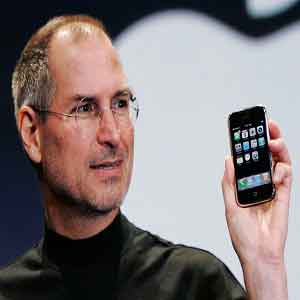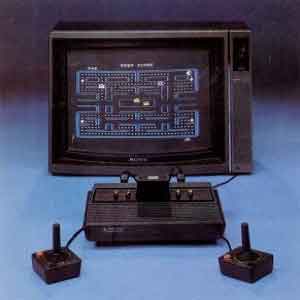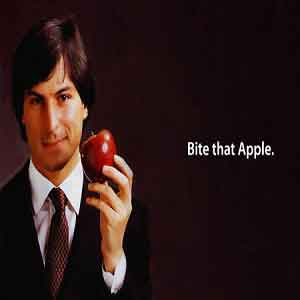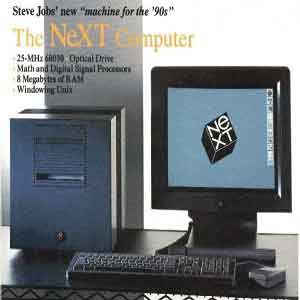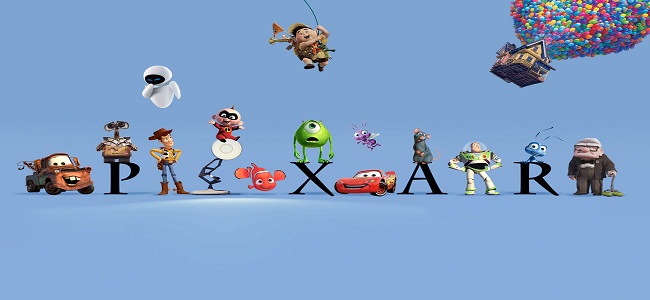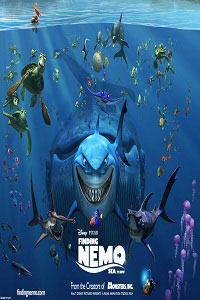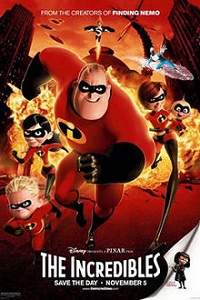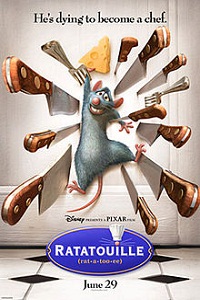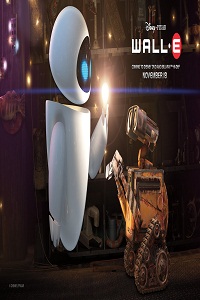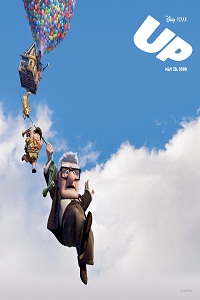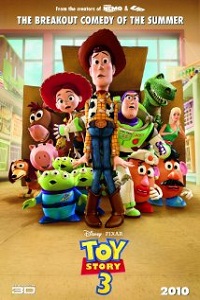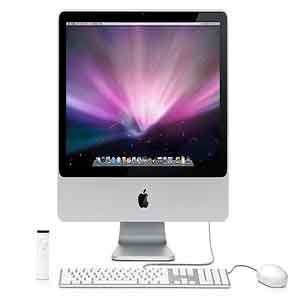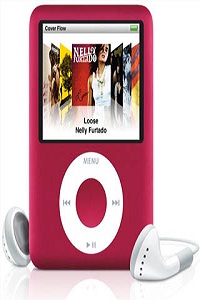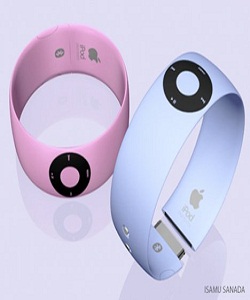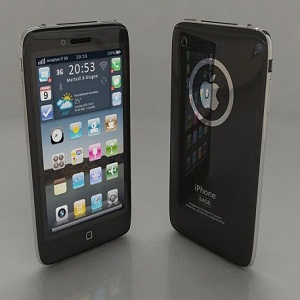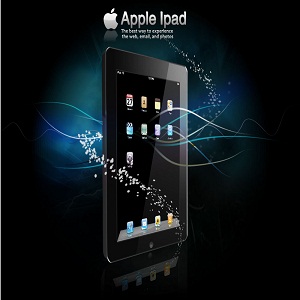Steve Jobs
The iMan
Steven Paul "Steve" Jobs (February 24, 1955 – October 5, 2011) was an American businessman and technology visionary. He is best known as the co-founder, chairman, and chief executive officer of Apple Inc. Through Apple, he was widely recognized as a charismatic pioneer of the personal computer revolution and for his influential career in the computer and consumer electronics fields. Jobs also co-founded and served as chief executive of Pixar Animation Studios; he became a member of the board of directors of The Walt Disney Company in 2006, when Disney acquired Pixar.
In the late 1970s, Apple co-founder Steve Wozniak engineered one of the first commercially successful lines of personal computers, the Apple II series. Jobs was among the first to see the commercial potential of Xerox PARC's mouse-driven graphical user interface, which led to the creation of the Apple Lisa and, one year later, the Macintosh. By introducing the LaserWriter he enabled a revolution called desktop publishing.
After losing a power struggle with the board of directors in 1985, Jobs left Apple and founded NeXT, a computer platform development company specializing in the higher-education and business markets.In 1986, he acquired the computer graphics division of Lucasfilm, which was spun off as Pixar. He was credited in Toy Story (1995) as an executive producer. He served as CEO and 50.1% majority shareholder until Disney bought Pixar in 2006.By 1996, Apple had failed to deliver a new operating system, Copland. Jobs returned to Apple as an advisor, and took control of the company as an interim CEO. Jobs brought Apple from near bankruptcy to profitability by 1998.
As the new CEO of the company, Jobs oversaw the development of the iMac, iTunes, iPod, iPhone, and iPad, and on the services side, the company's Apple Retail Stores, iTunes Store and the App Store. The success of these products and services, provided several years of stable financial returns, and propelled Apple to become the world's most valuable publicly traded company in 2011. The reinvigoration of the company is regarded by many commentators as one of the greatest turnarounds in business history.
Early life
Steven Paul Jobs was born in San Francisco on February 24, 1955 to two university students, Joanne Carole Schieble and Syrian-born Abdulfattah "John" Jandali, who were both unmarried at the time. Jandali, who was teaching in Wisconsin when Steve was born, said he had no choice but to put the baby up for adoption because his girlfriend's family objected to their relationship.
The baby was adopted at birth by Paul Reinhold Jobs (1922–1993) and Clara Jobs (1924–1986), an Armenian American whose maiden name was Hagopian. According to Steve Jobs's commencement address at Stanford, Schieble wanted Jobs to be adopted only by a college-graduate couple. Schieble learned that Clara Jobs didn't graduate from college and Paul Jobs only attended high school, but signed final adoption papers after they promised her that the child would definitely be encouraged and supported to attend college. Later, when asked about his "adoptive parents," Jobs replied emphatically that Paul and Clara Jobs "were my parents." He stated in his authorized biography that they "were my parents 1,000%." Unknown to him, his biological parents would subsequently marry (December 1955), have a second child Mona Simpson in 1957, and divorce in 1962.
The Jobs family moved from San Francisco to Mountain View, California when Steve was five years old. The parents later adopted a daughter, Patti. Paul was a machinist for a company that made lasers, and taught his son rudimentary electronics and how to work with his hands. The father showed Steve how to work on electronics in the family garage, demonstrating to his son how to take apart and rebuild electronics such as radios and televisions. As a result, Steve became interested in and developed a hobby of technical tinkering. Clara was an accountant who taught him to read before he went to school. Clara Jobs had been a payroll clerk for Varian Associates, one of the first high-tech firms in what became known as Silicon Valley.
Jobs's youth was riddled with frustrations over formal schooling. At Monta Loma Elementary school in Mountain View, he was a prankster whose fourth-grade teacher needed to bribe him to study. Jobs tested so well, however, that administrators wanted to skip him ahead to high school—a proposal his parents declined.
Jobs then attended Cupertino Junior High and Homestead High School in Cupertino, California. At Homestead, Jobs became friends with Bill Fernandez, a neighbor who shared the same interests in electronics. Fernandez introduced Jobs to another, older computer whiz kid, Stephen Wozniak (also known as "Woz"). In 1969 Woz started building a little computer board with Fernandez that they named “The Cream Soda Computerâ€, which they showed to Jobs; he seemed really interested. Jobs frequented after-school lectures at the Hewlett-Packard Company in Palo Alto, California, and was later hired there, working with Wozniak as a summer employee.
Following high school graduation in 1972, Jobs enrolled at Reed College in Portland, Oregon. Reed was an expensive college which Paul and Clara could ill afford. They were spending much of their life savings on their son’s higher education. Jobs dropped out of college after six months and spent the next 18 months dropping in on creative classes, including a course on calligraphy. He continued auditing classes at Reed while sleeping on the floor in friends' dorm rooms, returning Coke bottles for food money, and getting weekly free meals at the local Hare Krishna temple. Jobs later said, "If I had never dropped in on that single calligraphy course in college, the Mac would have never had multiple typefaces or proportionally spaced fonts."
In 1974, Jobs took a job as a technician at Atari, Inc. in Los Gatos, California. He traveled to India in mid-1974 to visit Neem Karoli Baba at his Kainchi Ashram with a Reed College friend (and, later, an early Apple employee), Daniel Kottke, in search of spiritual enlightenment. When they got to the Neem Karoli ashram, it was almost deserted as Neem Karoli Baba had died in September 1973. Then they made a long trek up a dry riverbed to an ashram of Hariakhan Baba. In India, they spent a lot of time on bus rides from Delhi to Uttar Pradesh and back, then up to Himachal Pradesh and back.
After staying for seven months, Jobs left India and returned to the US ahead of Daniel Kottke. Jobs then returned to Atari, and was assigned to create a circuit board for the arcade video game Breakout. According to Atari co-founder Nolan Bushnell, Atari offered $100 for each chip that was eliminated in the machine. Jobs had little specialized knowledge of circuit board design and made a deal with Wozniak to split the fee evenly between them if Wozniak could minimize the number of chips. Much to the amazement of Atari engineers, Wozniak reduced the number of chips by 50, a design so tight that it was impossible to reproduce on an assembly line.
In the early 1970s, Jobs and Wozniak were drawn to technology like a magnet. Wozniak had designed a low-cost digital "blue box" to generate the necessary tones to manipulate the telephone network, allowing free long-distance calls. Jobs decided that they could make money selling it. The clandestine sales of the illegal "blue boxes" went well, and perhaps planted the seed in Jobs's mind that electronics could be fun and profitable.
Jobs began attending meetings of the Homebrew Computer Club with Wozniak in 1975. He greatly admired Edwin H. Land, the inventor of instant photography and founder of Polaroid Corporation, and would explicitly model his own career after that of Land's.
The birth of Apple
In 1976, Jobs and Wozniak formed their own business, which they named “Apple Computer Company†in remembrance of a happy summer Jobs had spent picking apples. At first they started off selling circuit boards, but eventually they produced a complete computer prototype.
Jobs and Steve Wozniak met in 1971, when their mutual friend, Bill Fernandez, introduced 21-year-old Wozniak to 16-year-old Jobs. In 1976, Wozniak invented the Apple I computer. Jobs, Wozniak, and Ronald Wayne founded Apple computer in the garage of Jobs's parents in order to sell it. They received funding from a then-semi-retired Intel product-marketing manager and engineer Mike Markkula.
In 1978, Apple recruited Mike Scott from National Semiconductor to serve as CEO for what turned out to be several turbulent years. In 1983, Jobs lured John Sculley away from Pepsi-Cola to serve as Apple's CEO, asking, "Do you want to sell sugar water for the rest of your life, or do you want to come with me and change the world?"
In the early 1980s, Jobs was among the first to see the commercial potential of Xerox PARC's mouse-driven graphical user interface, which led to the creation of the Apple Lisa. One year later, Apple employee Jef Raskin invented the Macintosh.
The following year, Apple aired a Super Bowl television commercial titled "1984". At Apple's annual shareholders meeting on January 24, 1984, an emotional Jobs introduced the Macintosh to a wildly enthusiastic audience; Andy Hertzfeld described the scene as "pandemonium".
Apple logo in 1977, created by Rob Janoff with the rainbow color theme used until 1998. While Jobs was a persuasive and charismatic director for Apple, some of his employees from that time described him as an erratic and temperamental manager. Sculley learned that Jobs—who believed Sculley to be "bad for Apple" and the wrong person to lead the company—had been attempting to organize a boardroom coup, and on May 24, 1985, called a board meeting to resolve the matter. Apple's board of directors sided with Sculley and removed Jobs from his managerial duties as head of the Macintosh division. Jobs resigned from Apple five months later and founded NeXT Inc. the same year.
In a speech Jobs gave at Stanford University in 2005, he said being fired from Apple was the best thing that could have happened to him; "The heaviness of being successful was replaced by the lightness of being a beginner again, less sure about everything. It freed me to enter one of the most creative periods of my life." And he added, "I'm pretty sure none of this would have happened if I hadn't been fired from Apple. It was awful-tasting medicine, but I guess the patient needed it."
A NeXTstation with the original keyboard, mouse and the NeXT MegaPixel monitor After leaving Apple, Jobs founded NeXT Computer in 1985, with $7 million. He attracted the attention of billionaire Ross Perot who invested heavily in the company. NeXT workstations were first released in 1990, priced at $9,999. Like the Apple Lisa, the NeXT workstation was technologically advanced, but was largely dismissed as cost-prohibitive by the educational sector for which it was designed. The NeXT workstation was known for its technical strengths, chief among them its object-oriented software development system. Jobs marketed NeXT products to the financial, scientific, and academic community, highlighting its innovative, experimental new technologies, such as the Mach kernel, the digital signal processor chip, and the built-in Ethernet port. Tim Berners-Lee invented the World Wide Web on a NeXT computer at CERN.
The revised, second-generation NeXTcube was released in 1990, also. Jobs touted it as the first "interpersonal" computer that would replace the personal computer. With its innovative NeXTMail multimedia email system, NeXTcube could share voice, image, graphics, and video in email for the first time. "Interpersonal computing is going to revolutionize human communications and groupwork", Jobs told reporters. Jobs ran NeXT with an obsession for aesthetic perfection, as evidenced by the development of and attention to NeXTcube's magnesium case.
In 1986, Jobs bought The Graphics Group (later renamed Pixar) from Lucasfilm's computer graphics division for the price of $10 million, $5 million of which was given to the company as capital. The first film produced by the partnership, Toy Story, with Jobs credited as executive producer, brought fame and critical acclaim to the studio when it was released in 1995. Over the next 15 years, under Pixar's creative chief John Lasseter, the company produced box-office hits A Bug's Life(1998) ; Toy Story 2 (1999); Monsters, Inc. (2001); Finding Nemo (2003); The Incredibles (2004); Cars (2006); Ratatouille (2007); WALL-E (2008); Up (2009); and Toy Story 3 (2010). Finding Nemo, The Incredibles, Ratatouille, WALL-E, Up and Toy Story 3 each received the Academy Award for Best Animated Feature, an award introduced in 2001.
On January 24, 2006, Jobs and Iger announced that Disney had agreed to purchase Pixar in an all-stock transaction worth $7.4 billion. When the deal closed, Jobs became The Walt Disney Company's largest single shareholder with approximately seven percent of the company's stock. Jobs joined the company's board of directors upon completion of the merger and also helped oversee Disney and Pixar's combined animation businesses from a seat on a special six-person steering committee. Upon Jobs's death his shares in Disney were transferred to the Steven P. Jobs Trust led by Laurene Jobs.
Return to Apple
In 1996, Apple announced that it would buy NeXT for $427 million. The deal was finalized in late 1996, bringing Jobs back to the company he co-founded. Jobs became de facto chief after then-CEO Gil Amelio was ousted in July 1997. He was formally named interim chief executive in September. In March 1998, to concentrate Apple's efforts on returning to profitability, Jobs terminated a number of projects, such as Newton, Cyberdog, and OpenDoc. In the coming months, many employees developed a fear of encountering Jobs while riding in the elevator, "afraid that they might not have a job when the doors opened. The reality was that Jobs's summary executions were rare, but a handful of victims was enough to terrorize a whole company." Jobs also changed the licensing program for Macintosh clones, making it too costly for the manufacturers to continue making machines.
With the purchase of NeXT, much of the company's technology found its way into Apple products, most notably NeXTSTEP, which evolved into Mac OS X. Under Jobs's guidance, the company increased sales significantly with the introduction of the iMac and other new products; since then, appealing designs and powerful branding have worked well for Apple. At the 2000 Macworld Expo, Jobs officially dropped the "interim" modifier from his title at Apple and became permanent CEO. Jobs quipped at the time that he would be using the title "iCEO".
The company subsequently branched out, introducing and improving upon other digital appliances. With the introduction of the iPod portable music player, iTunes digital music software, and the iTunes Store, the company made forays into consumer electronics and music distribution. On June 29, 2007, Apple entered the cellular phone business with the introduction of the iPhone, a multi-touch display cell phone, which also included the features of an iPod and, with its own mobile browser, revolutionized the mobile browsing scene. While stimulating innovation, Jobs also reminded his employees that "real artists ship".
iMac
Apple iMac was introduced in 1998 and its innovative design was directly the result of Jobs's return to Apple. Apple boasted "the back of our computer looks better than the front of anyone else's". Described as "cartoonlike" the first iMac, clad in Bondi Blue plastic, was unlike any personal computer that came before. In 1999, Apple introduced Graphite gray Apple iMac and since has switched to all-white. Design ideas were intended to create a connection with the user such as the handle and a breathing light effect when the computer went to sleep.. The Apple iMac sold for $1,299 at that time. There were some technical revolutions for iMac too. The USB ports being the only device inputs on the iMac. So the iMac’s success helped popularize the interface among third party peripheral makers, which is evidenced by the fact that many early USB peripherals were made of translucent plastic to match the iMac design.
iPod
The first generation of iPod was released October 23, 2001. The major innovation of the iPod was its small size achieved by using a 1.8" hard drive compared to the 2.5" drives common to players at that time. The capacity of the first generation iPod ranged from 5G to 10 Gigabytes. The iPod sold for US$399 and more than 100,000 iPods were sold before the end of 2001. The introduction of the iPod resulted in Apple becoming a major player in the music industry.
Also, the iPod’s success prepared the way for the iTunes music store and the iPhone. After the 1st generation of iPod, Apple released the hard drive-based iPod classic, the touchscreen iPod Touch, video-capable iPod Nano, screenless iPod Shuffle in the following years. The iPod Shuffle bracelet is a new concept designed to be worn on your wrist and it streams music via bluetooth to a set of wireless headphones.
iPhone
Jobs began work on the first iPhone in 2005 and the first iPhone was released on June 29, 2007. The iPhone created such a sensation that a survey indicated six out of ten Americans were aware of its release. Time magazine declared it "Invention of the Year" for 2007. The Apple iPhone is a small device with multimedia capabilities and functions as a quad-band touch screen smartphone. A year later, the iPhone 3G was released in July 2008 with the key feature was support for GPS, 3G data and quad-band UMTS/HSDPA. In June 2009, the iPhone 3GS, added voice control, a better camera, and a faster processor was introduced by Phil Schiller. iPhone 4 was thinner than previous models, had a five megapixel camera which can record videos in 720p HD, and added a secondary front facing camera for video calls. A major feature of the iPhone 4S, introduced in October 2011, was Siri, which is a virtual assistant that is capable of voice recognition.
iPad
The iPad is a line of tablet computers designed primarily as a platform for audio-visual media including books, periodicals, movies, music, games, apps and web content. Its size and weight fall between those of contemporary smartphones and laptop computers. The iPad runs on iOS, the same operating system used on Apple's iPod Touch and iPhone, and can run its own applications as well as iPhone applications. Without modification or a developer certificate, the iPad will only run programs approved by Apple and distributed via the Apple App Store (with the exception of programs that run inside the iPad's web browser).
Recognitions and criticisms
Jobs was both admired and criticized for his consummate skill at persuasion and salesmanship, which has been dubbed the "reality distortion field" and was particularly evident during his keynote speeches (colloquially known as "Stevenotes") at Macworld Expos and at Apple Worldwide Developers Conferences. In 2005, Jobs responded to criticism of Apple's poor recycling programs for e-waste in the US by lashing out at environmental and other advocates at Apple's Annual Meeting in Cupertino in April. A few weeks later, Apple announced it would take back iPods for free at its retail stores. The Computer TakeBack Campaign responded by flying a banner from a plane over the Stanford University graduation at which Jobs was the commencement speaker. The banner read "Steve, don't be a mini-player—recycle all e-waste".
In 2006, he further expanded Apple's recycling programs to any US customer who buys a new Mac. This program includes shipping and "environmentally friendly disposal" of their old systems.
In August 2011, Jobs resigned as CEO of Apple, but remained with the company as chairman of the company's board. Hours after the announcement, Apple Inc. (AAPL) shares dropped five percent in after-hours trading. This relatively small drop, when considering the importance of Jobs to Apple, was associated with the fact that his health had been in the news for several years, and he had been on medical leave since January 2011. It was believed, according to Forbes, that the impact would be felt in a negative way beyond Apple, including at The Walt Disney Company where Jobs served as director. In after-hours trading on the day of the announcement, Walt Disney Co. (DIS) shares dropped 1.5 percent.
In 2003, Jobs was diagnosed with a pancreas neuroendocrine tumor. Though it was initially treated, he reported a hormone imbalance, underwent a liver transplant in 2009, and appeared progressively thinner as his health declined. On medical leave for most of 2011, Jobs resigned in August that year, and was elected Chairman of the Board. He died of respiratory arrest related to his metastatic tumor on October 5, 2011. Jobs has received a number of honors and public recognition for his influence in the technology and music industries. He has widely been referred to as "legendary", a "futurist" or simply "visionary", and has been described as the "Father of the Digital Revolution", a "master of innovation", and a "design perfectionist".
Death
Jobs died at his Palo Alto, California home around 3 p.m. (PDT) on October 5, 2011, because of complications resulting in respiratory arrest. A small private funeral was held on October 7, 2011, of which details were not revealed out of respect to Jobs's family.
Apple and Pixar each issued announcements of his death. Apple announced on the same day that they had no plans for a public service, but were encouraging "well-wishers" to send their remembrance messages to an email address created to receive such messages. Both Apple and Microsoft flew their flags at half-staff throughout their respective headquarters and campuses.
Jobs is buried in an unmarked grave at Alta Mesa Memorial Park, the only nondenominational cemetery in Palo Alto.
